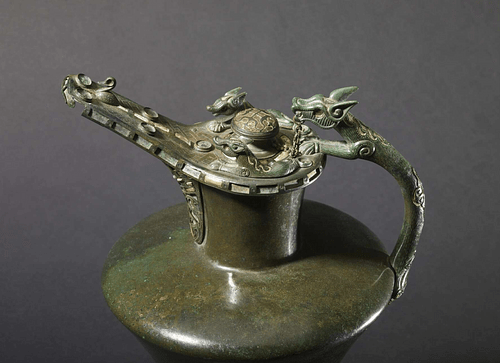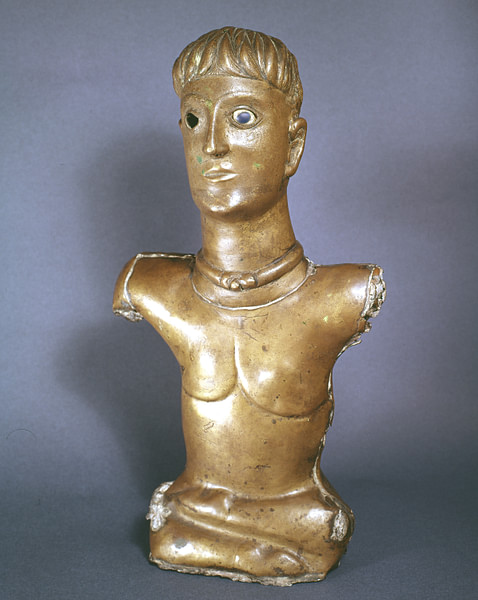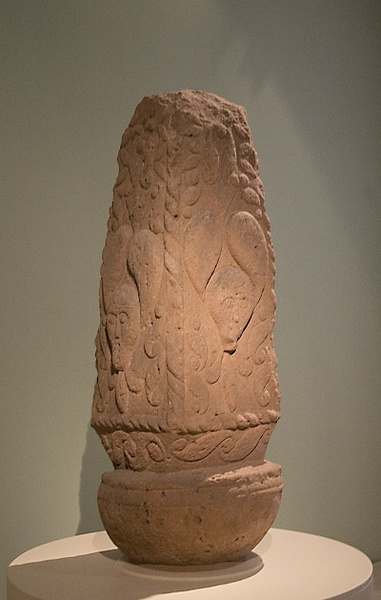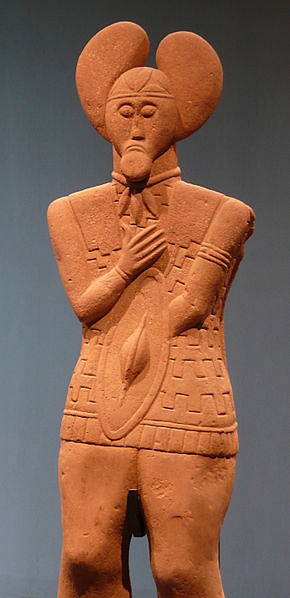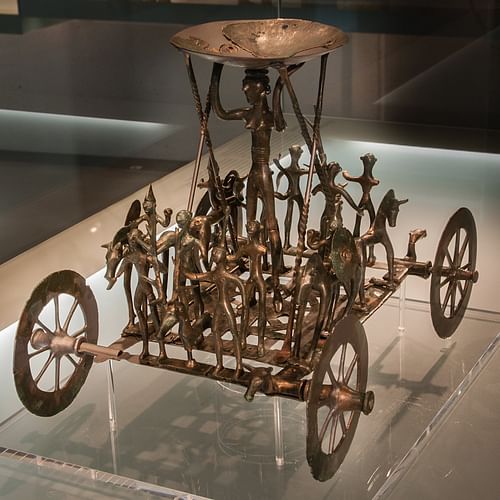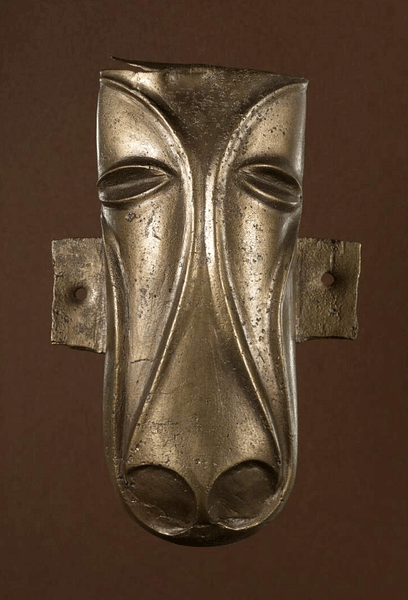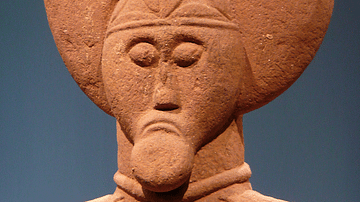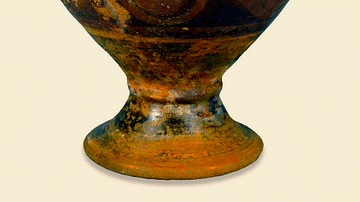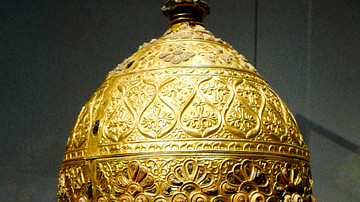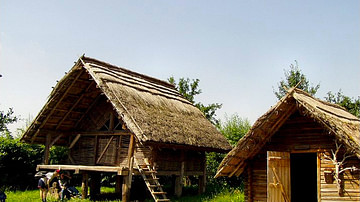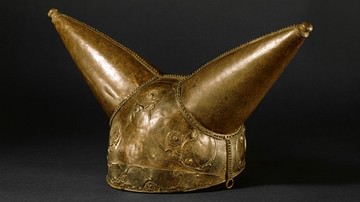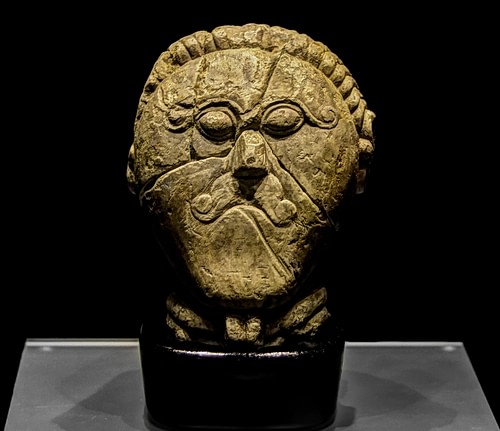
The sculpture of the ancient Celts between 700 BCE and 400 CE is nothing if not varied as artists across Europe developed their own ideas and borrowed what interested them from neighbouring cultures. Early Celtic stone and wood sculptures focus on the human form, especially heads. Such works usually represent gods and heroic warrior figures but are often abstract with typical facial features being lentoid eyes, a bulbous nose, and swept-back hair. Animals, both real and imagined, were another favourite subject, especially in miniature form in metal to adorn all manner of objects such as cauldrons, chariots, helmet crests, and jugs. Vegetal designs and swirling complex lines added extra decoration to objects and became a feature that stayed with Celtic art as it developed through the medieval period. Celtic art, in general, has enjoyed a tremendous revival from the 19th century CE up to the present day and many of the motifs which are so quintessentially 'Celtic' have their origins in the artworks produced 2,000 years ago.
Themes
The ancient peoples who spoke the Celtic language occupied territories from Iberia to Bohemia through the 1st millennium BCE and several centuries into the 1st millennium CE. The Celts in any particular area of western and central Europe had no concept they were part of a wider culture with similar approaches to religion and culture. Then, like many other long-lasting cultures, the sculpture of the Celts evolved over time, receiving influences from the cultures in the Near East and the Greeks, Etruscans, Scythians, Thracians and Romans, and, of course, from other Celts. Any treatment of ancient Celtic art is obliged, therefore, to be a general one. A further difficulty is that the Celts left very few written records and so we have no commentaries from the creators themselves on what inspired their art, what their art was intended to represent, or how it was to be used. We must judge Celtic art largely by examining only the art objects themselves and the contexts in which they have been rediscovered.
Despite these problems of definition and study, there are certainly some common themes which are expressed in Celtic sculpture wherever pieces have been found. Further, Celtic art is not restricted to prestige items but is found everywhere from large figure sculptures in stone to the humblest of clothing pins; even such highly functional items as wine flagons and fire-dogs (used to roast meat on) were embellished with ornate heads of animals.
Three subjects stand out as being of particular interest to ancient Celtic sculptors: Gods, warriors, and animals. Sculptures are rarely life-size, but this may be because examples have simply not survived. In addition, it is the head which seems to have captured the Celtic imagination most of all. Heads were considered the containers of the soul and so were especially important in Celtic religion and warfare (where they were collected as trophies). It is not surprising, then, to see the head dominate Celtic sculpture. Human heads, and many of the animals in Celtic art, are typically stylized, they often have swept-back hair, a bulbous nose, and lentoid eyes. Over time, the Celtic love of heads in sculpture seems to have diminished and been replaced by other forms but they are, nevertheless, still seen in engraved areas of other objects where they are surrounded by a camouflage of foliage and linear motifs, often, too, rendered in a highly abstract manner but visible to the trained eye.
Media
In terms of media, Celtic sculptors used stone, wood, and metals for their work. Metals such as bronze, iron, gold, and silver were usually cast but could also be hammered from sheets. Extra form and decoration were achieved via engraving, punching, tracing, and repoussé (grooving the material from behind to create a relief on the other side). The more intricate designs were achieved using a compass and marking faint lines on the piece. There are even surviving bone pieces, which craftworkers used as a trial run before embarking on a work of more precious material. Details were added to sculptures of all kinds using colourful materials such as glass (especially red), coral, shell, amber, semi-precious stones, and enamel.
Religious Sculpture
A figure which appears more frequently than most others in ancient Celtic art is the god Cernunnos who represented nature, flora and fauna, and fertility. Typically portrayed wearing stag antlers or horns, the god appears in the 1st-century CE Gallo-Roman Nautae Parisiaci monument where he has a torc hanging from each of his horns. Another possible depiction of Cernunnos, this time in the form of a 1st-century BCE bronze figure found in the Juine river at Bouray near Paris in 1845 CE, has him wearing a torc around his neck. The figure is sat cross-legged and his shortened legs end in hooves. The eyes are made of glass inlay (only one survives). The figure is 42 centimetres tall and is now on display in the Archaeological Museum of Château de Saint-Germain-en-Laye, Yvelines, France.
The limestone double head from Roquepertuse in southern France is an important work since it shows traces of paint and so indicates Celtic sculpture was not perhaps as stark as we today imagine it. It dates to the 3rd or 2nd century BCE. In addition, the piece, with its two heads back to back, each with a different face, reminds that Celtic artists, like those just about anywhere else, were influenced by new ideas, in this case, the Greek statues of Hermes.
Another mysterious Celtic sculpture is the sandstone Mšecké Žehrovice Head from a sanctuary in the Czech Republic. Dating to around the 2nd century BCE, the head has a thick torc around the neck, indicating it is likely a warrior-deity or cultural hero. Curiously, the head was broken into several pieces and then buried in a sandpit along with broken pottery and animal bones. The head is on display in the National Museum, Prague.
The Cleveland Walk stone plaque shows a trio of goddesses. Made during the Roman period, it has been identified as Celtic because of the Celtic belief in deities having triple aspects, which increased their potency. Such a goddess with three different forms is the warrior-goddess the Mórrigan. Today, the plaque is on display in the Roman Bath Museum, Bath, England.
Even more enigmatic than the Mšecké Žehrovice Head and the Mórrigan sculpture are wooden statues miraculously retrieved from lakes and bogs which preserved organic material that would have otherwise long since disappeared. Typically made of oak, these standing figures have only the most rudimentary features and very often are depicted wearing a long hooded cloak. Perhaps stood at sacred sites and decorated with a torc around their necks, they probably represented Celtic gods. A fine example comes from Lake Geneva and dates to around 80 BCE. In contrast, the celebrated 1st-century BCE figure from Euffigenix, which shows a deity wearing a torc and with a boar design vertically on the body, is made from limestone but it seems to be a copy of these wooden statues, suggesting they were widespread in the Celtic world.
Finally, carved stones were a feature of Celtic sculpture. Several examples survive in Ireland and Gaul. Typical stones are shaped into domes or four-sided pyramids and are covered in abstract designs of lines, swirls, and vegetal motifs. They may have represented a Celtic view of the universe and been placed at sacred sites. A fine early example is the 5th-4th-century BCE stone pillar from Pfalzfeld, St. Goar, Germany (now in the Rheinisches Landesmuseum, Bonn). The pillar is 1.48 metres (4 ft 8 in) tall and was once topped by a head. Divided into four sides by vertical cable reliefs, each face has a human head wearing a headdress known as a ‘leaf crown’ and a stylized beard of three points. The spaces are filled with geometric designs, notably s-shapes reminiscent of Celtic fibulae. A later example of this type of object is the granite Turoe Stone from Galway which dates to the 1st century BCE.
Warrior Figures
Naked warriors wearing only a sword belt and neck torc were a common subject for Celtic sculptors. A rare piece for its size, and one of the earliest surviving Celtic figure-sculptures, is the life-size figure of an ithyphallic warrior from Hirschlanden near Ludwigsburg, Germany. Made from sandstone, the piece likely stood on a nearby hilltop. It possibly dates to the 6th century BCE and shows an Etruscan influence. The nude figure wears only a belt with a dagger and a neck torc. Of particular interest is his headgear, likely a hat made from birch-bark, examples of which were found in a nearby tomb. The statue is now in the Württembergisches Landesmuseum in Stuttgart.
A life-sized sandstone statue of a Celtic warrior, sometimes called the “Prince of Glauberg’, was excavated from Glauberg, Germany. The warrior, who carries a shield, is wearing a mail tunic and a torc necklace with three pendants. He also wears an elaborate headdress of the ‘leaf crown’ type. The statue was found in 1996 CE near an already excavated Celtic tomb which dates to the second half of the 5th century BCE, and the jewellery worn by the statue is similar to that worn by the deceased warrior in the tomb. The statue is on display in the Glauberg Museum.
A celebrated terracotta figurine of a Celtic warrior was found and made in Egypt and dates to the period 220-180 BCE. Likely a Gaulish mercenary in the service of the Ptolemaic army, the figure wears nothing except a cloak and a sword belt while he carries the long oblong shield familiar to Celtic warfare. The figure is hollow and was made using a two-piece mould. Today the figurine is on display in the British Museum, London.
A much more dynamic figure than those already mentioned is the warrior wearing a horned helmet and about to launch a lance which is now in the Staatliche Museum, Berlin. The bronze figurine wears nothing but a sword belt and torc. Even smaller still, but no less impressive, are the group of warrior figures which make up the base for the Strettweg Cult Wagon. This bronze work, which dates to the 6th century BCE, was found in a tomb in Steiermark, Austria, and is a fine example of the Celtic love of small figurines which can adorn anything from furniture to chariots. The larger central figure is female, and she supports a base upon which a cauldron would have been placed for ritual use; her elongated limbs, and those of the warriors around her, are reminiscent of Greek pottery figures. The wagon is on display in the archaeological museum of Schloss Eggenberg, Graz, Austria.
Animal Figures
Animals were a very popular subject in ancient Celtic art. This is not surprising since the Celts believed that animal totems on weapons, armour, and shields protected the wearer and instilled in them the properties and characteristics of particular animals. Frequently represented animals include the bull, horse, stag, and boar. Small-scale animal sculptures were used for helmet crests but can be most frequently seen in Celtic brooches. A fine example of a horse figurine from a brooch dates to 650-550 BCE and is now on display in the Metropolitan Museum of Art, New York. Under the influence of the Romans, Celtic artists made figurine brooches with fantastical animals or those which mixed animal and human features. Another area where fantastic beasts make an appearance is the ends of bronze horns used by the Celts to rouse themselves on the battlefield.
A fine example of the Celtic love of bizarre creatures combined with the severed head theme is the ‘Tarasque de Noves’, a limestone sculpture of a seated hound from southern Gaul. The creature has each of its paws resting on a severed human head and is eating a third victim whose arm hangs from its snarling mouth. The sculpture, which is 1.2 metres (3.5 ft) tall, perhaps shows Roman influence although it could be as early as the 2nd century BCE. It is now on display in the Calvet Museum, Avignon, France.
An interesting piece of abstract Celtic art is the bronze horse head mask which was discovered as part of the Stanwick Hoard of North Yorkshire, England. The mask is made from a single metal sheet and has highly stylized eyes, nostrils, and nose bridge, all rendered in shallow relief. The piece is concave and has side brackets to attach it to another object, perhaps an item made of wood like a bucket. It measures 98.6 cm (38.8 in) in length and 63.6 cm (25 in) in width. It dates to the period 50 BCE to 100 CE and is now in the British Museum. Over the following centuries, and as the Christianization of Europe influenced art, this love of the abstract by ancient Celtic artists found expression no longer in sculpture like the Stanwick Horse Mask but in other media such as the brooches, illuminated manuscripts, and stone crosses, all of which typified Celtic art through the Middle Ages.
